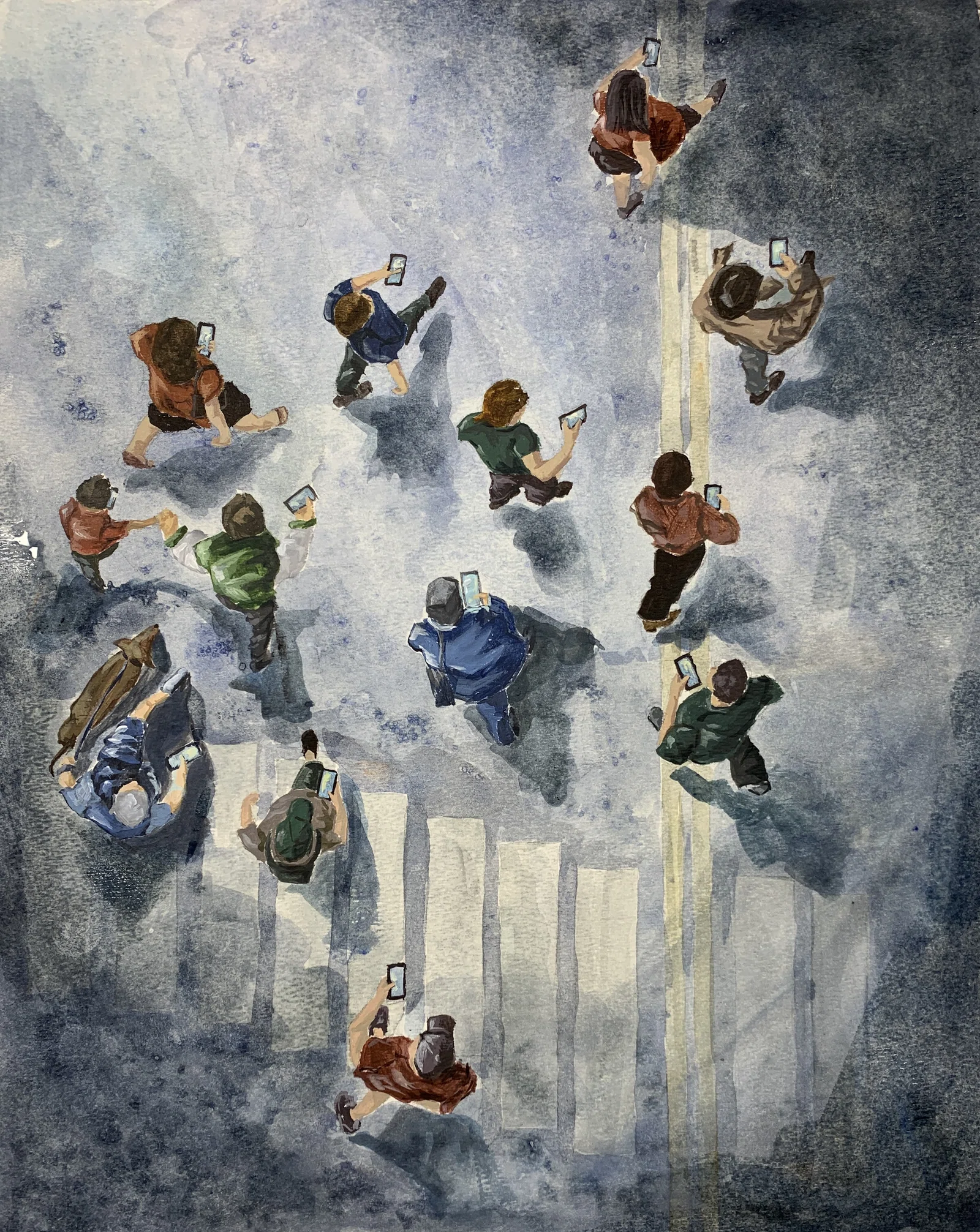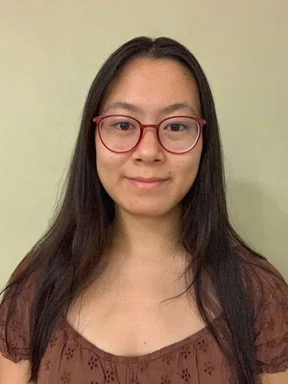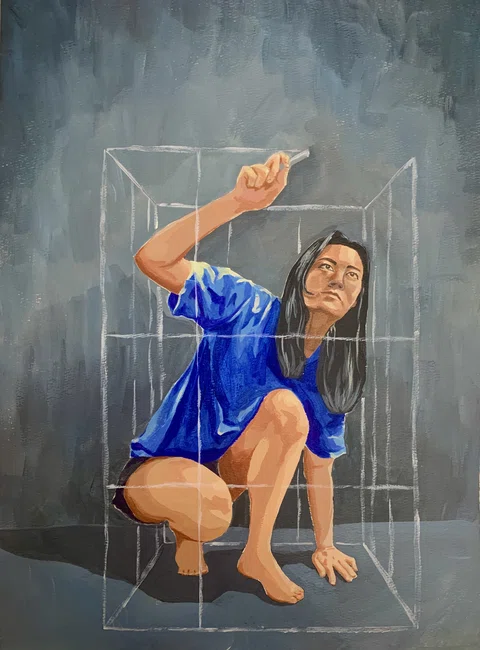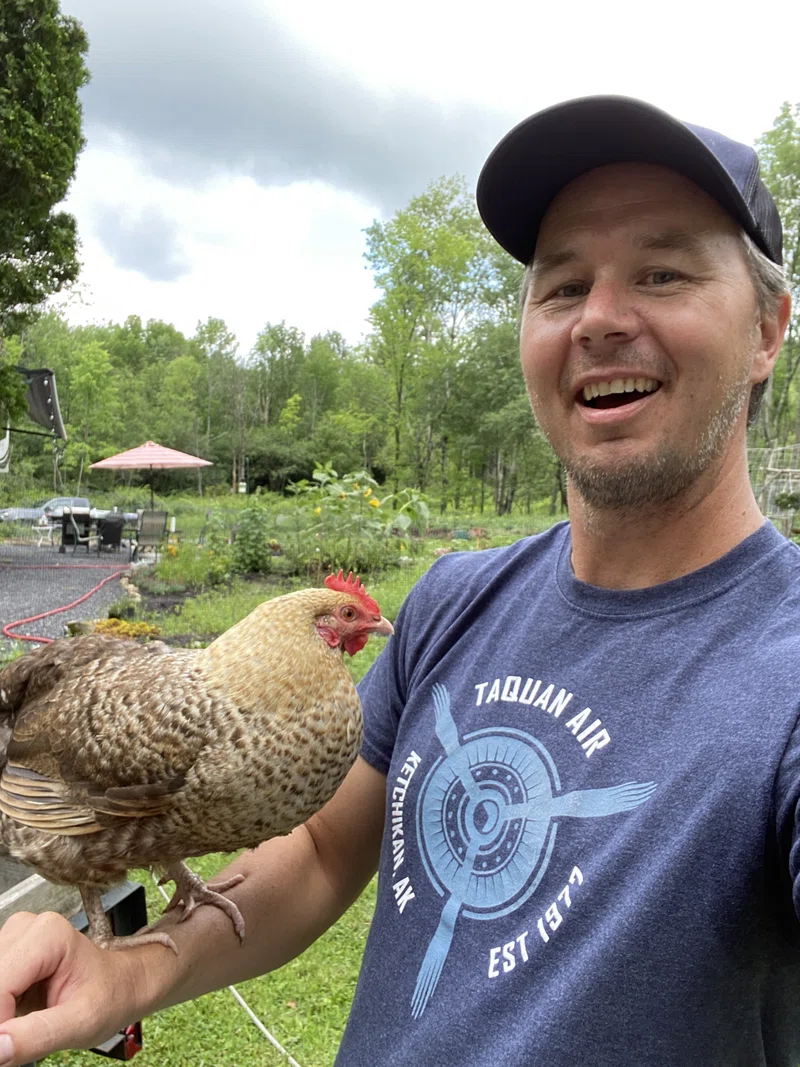





Drawing
Yiru Zhou
Chatham High School|Chatham, New Jersey

Phones: Connectors or Barriers?|12.2 x 13.2 in.
Material(s): Acrylic paint, watercolor, and salt
Process(es): High contrast background sprinkled with salt. Unique high perspective highlights phones/barriers.
Curatorial Note: Strong point of view while experimenting with materials and processes to support the idea.




“I wanted to experiment with how barriers could be portrayed through watercolor techniques. I conducted experiments, such as using wax resist, plastic wrap, or salt, which allowed me to better portray barriers throughout my pieces. I found that contrast in color, texture, or style can help enhance the feeling of a barrier.”
Student statement
Student
statement
My sustained investigation topic was “barriers.” With this one-word theme, I was able to allow myself creativity to loosely interpret how “barriers” could be portrayed through my artwork. Near the beginning of my sustained investigation, I wanted to experiment with how I could stretch the possibilities of the mediums I chose: watercolor and acrylic. In order to inspire ideas, I researched nontraditional watercolor techniques and then experimented with these techniques. Some of my favorite techniques were using salt in wet watercolors to create a marbled texture and also using crayons as a wax resist. I ended up using both of these techniques in later artworks, and I found that this experiment inspired me to add texture to my pieces. The use of texture helped me throughout my sustained investigation to differentiate between the two divided sides of the barriers.
One piece that was inspired by my experiment with watercolor techniques was called Phones: Connectors or Barriers? This piece focuses on the duality of technology and cell phones in our everyday lives. While they do connect people from miles away, they can also be isolating as people start to form less personal connections. In this piece, I depicted a busy street of people, yet an isolating and lonely sense is conveyed through the singular focus on the phones, which is highlighted through the bird’s eye view. In the background of this piece, I added salt into wet watercolor, which added a subtle rough and ragged texture to the piece and also resembled the asphalt road.




Yiru Zhou

A Self-Imposed Cage|17 x 13 in.
Material(s): I used acrylic paint on watercolor paper.
Process(es): textured brushstrokes depict real vs intangible world. Saturated vs grey colors highlights person.
My other piece is titled A Self-Imposed Cage and focuses on how during struggles, we frequently and unknowingly set restrictions for ourselves. While going through some difficulties this year, I started to realize how I limited myself by thinking, “I can’t do it” or “I’m not good enough,” without realizing how this was impacting me. What prevented me from achieving my best was not an outside factor but rather my own self-doubt. This inspired me to create a piece depicting this unseen yet dangerous barrier. When I first started my sustained investigation, I focused on tangible barriers, yet I realized that these unseen barriers can be just as prominent in society. While drafting this piece, I struggled to accurately depict this barrier—I had to give shape to an unseen and abstract concept. I sketched out multiple possibilities and then eliminated them one by one until I decided to use the metaphorical cage idea. The cage, though seen in the painting, represents the mental barriers people are trapped by.
In this painting, I purposely had the person draw the cage around herself to show self-sabotage. Also, with the final strokes of the cage still being added, I was able to depict how the process of mental blocks is ongoing and doesn’t have a clear beginning or end. In order to differentiate between the symbolic barrier and the real person, I used a sketchy and dry brush stroke to draw the cage to imitate the texture of chalk. In this piece, I also opted for a more simple and almost cartoonish way of coloring the figure. I think this departure from realism hints at the metaphorical cage since this painting takes place in a figurative setting. I also have a lot of empty space in the background left, which adds to the barren and dark atmosphere while also emphasizing how the cage is restricting.
During my journey of completing my sustained investigation, I am very grateful for the guidance I received from my art teacher in school and also my private art teachers. They guided me by asking questions and giving constructive criticism throughout my drafting process, allowing me to be able to convey my ideas in the clearest ways possible. My advice for AP Art and Design students would be to ask for lots and lots of feedback! With the fresh eyes of others, they can catch parts of your artwork that lack clarity or needs more editing.
Teacher Statement
Teacher Statement
Eric Hreha
The essential intent of the School District of the Chathams is to discover and grow the gifts within each child. The Visual Arts Department accomplishes this intent by providing students with the opportunity to build upon their existing artistic and collaborative skills in a supportive, enriching, and inspirational environment.
We are extremely proud of the accomplishments of all our learners and, most recently, the achievements of Yiru Zhou. Working with Yiru, we’ve learned how important one-on-one conversations are and the value of mentor feedback. Yiru was a student who always sought input on her art and writing and then implemented this feedback into future work and revisions.

We’ve recognized that the usage of reflective writing in sketchbooks and in-class discussion boards has been integral to our students’ ability to articulate their artistic intentions and receive written feedback from their peers. This sketchbook has been a valuable tool in developing our students’ skills for inquiry. Often, we will ask students to pair up and share their learnings from their sketchbooks and identify common interests. These students will group up and practice particular skills or share ideas that relate to their Sustained Investigations. As part of the sketchbook assignments, we ask that students explore a variety of wet and dry media, as well as drawing surfaces that may relate to their ideas. Students are required to revise at least one piece in their portfolio and make a comparative written analysis of both works.
Material(s): Sketchbook, watercolor paper, watercolor paint, salt, crayons, plastic wrap, watercolor resist
Process(es): Experiment with unusual watercolor techniques such as plastic wrap or salt for adding texture.
At the beginning of the year, we allocate time for conferencing with students, creating lists, and brainstorming ideas about their Sustained Investigation in their sketchbooks. The summer before the AP Art and Design Course begins, students work almost exclusively in their sketch journals completing a variety of tasks and generating possible inquiries. Working with prompts and sentence starters, students develop a backbone for their inquiry which will be used for the upcoming year.
Along the way, individualized goal setting has been extremely productive for our students. Whether goals are set daily, weekly or monthly, students who have specific objectives tailored to their artistic interests become more successful in the course. Each year, we also schedule a summative mid-year review that gives students an opportunity to celebrate the work created up to this point. This review also functions as a space for students to reflect, refocus, and renew their creative energy moving forward.
The most helpful thing AP Art and Design teachers can do is get to know their students as soon as possible. Before any projects are due, talk with them about their interests and what their Sustained Investigation Inquiry might be. Sketching out the road map for the year early will allow everyone to have common goals and a mutual understanding of the long and short-term goals of the course.

Material(s): Sketchbook, pencil, color pencil
Process(es): Brainstorming/sketching process of multiple ways to show self-imposed barriers.
Yiru Zhou














